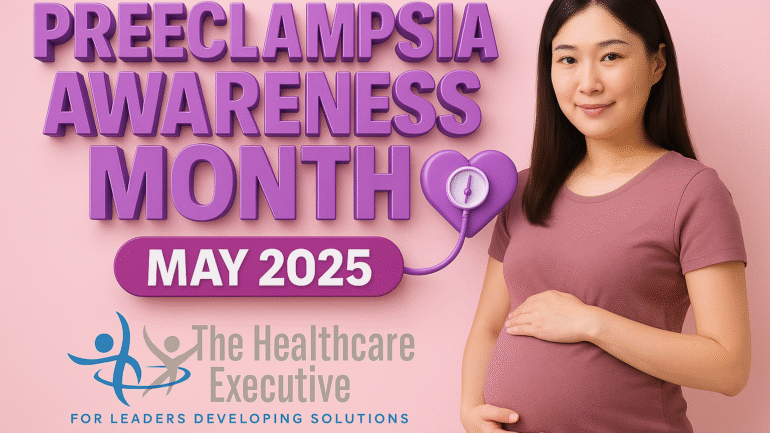Preeclampsia Awareness Month – May 2025

- Posted by Greg Wahlstrom, MBA, HCM
- Posted in Health Observance Calendar
Hospital Leadership in Maternal Safety and Clinical Vigilance
Published: May 1, 2025
Each May, Preeclampsia Awareness Month brings national attention to one of the leading causes of maternal and perinatal morbidity and mortality. Affecting up to 1 in 25 pregnancies in the United States, preeclampsia is a hypertensive disorder that can develop suddenly, even in previously healthy pregnancies. Symptoms may include high blood pressure, proteinuria, severe headaches, vision changes, and organ dysfunction—and when left undetected, the consequences can be fatal. For hospital executives, this observance serves as a call to action to ensure that maternal safety is embedded across emergency protocols, obstetric triage, inpatient workflows, and outpatient prenatal education. Institutions such as University of Rochester Medical Center are advancing maternal-fetal medicine models that connect patients with specialized care teams early in pregnancy to manage complications like preeclampsia and ensure the best possible outcomes. Executive oversight must prioritize standardized preeclampsia screening and timely intervention. Beyond clinical vigilance, this month is also about affirming maternal dignity, equity, and responsive leadership.
From a systems operations standpoint, addressing preeclampsia demands cross-departmental coordination and clinician alignment. Preeclampsia can present quickly and progress rapidly, making early identification and escalation critical. At Montefiore’s Children’s Hospitals, fetal medicine researchers are advancing predictive models for placental disease and hypertensive pregnancy disorders laying the scientific groundwork for earlier detection, interdisciplinary response, and reduce maternal morbidity across hospital systems. Clinical teams must be trained to recognize early signs of deterioration and apply the most recent management guidelines, including the use of magnesium sulfate and timely delivery when necessary. Electronic health records should flag risk factors such as previous hypertensive disorders, autoimmune conditions, or multiple gestations. In addition, hospital pharmacies must ensure consistent access to blood pressure medications, antihypertensives, and emergency protocols for seizure prevention. Executive leaders must evaluate whether their facilities are equipped to respond 24/7, including rural or satellite locations. The safety of birthing people must not be determined by ZIP code, coverage status, or implicit bias. Standardization, simulation training, and real-time auditing are not optional—they are the foundation of maternal safety systems.
Preeclampsia also reveals deeper equity gaps that hospital executives must confront. Black, Indigenous, and Asian American women experience higher rates of preeclampsia and are more likely to suffer complications due to delayed diagnosis or care disparities. Structural racism, language barriers, and limited access to specialty services continue to undermine safe pregnancies in underserved populations. Northside Hospital is raising awareness that preeclampsia can continue to pose serious risk even after childbirth, a message essential to improving equity and postpartum vigilance across hospital systems. Executives must ensure that interpreters, culturally appropriate education materials, and equity dashboards are integrated into their quality frameworks. Screening for social determinants of health—such as food insecurity, transportation challenges, and housing instability—should occur during all prenatal encounters. Moreover, governance boards must review maternal outcomes by race, language, and payer type to hold systems accountable. Equity in preeclampsia care is not an aspirational concept—it’s a measurable, mission-critical outcome that affects both maternal and neonatal survival. Hospital leaders must take ownership of that data and act decisively.
May also offers an opportunity for hospitals to lead public campaigns on preeclampsia prevention and education. Hospital systems can organize blood pressure screening days, community webinars, and continuing medical education for local providers. At Henry Ford Health in Michigan, maternal care teams are actively educating patients on the early signs of preeclampsia and encouraging home blood pressure monitoring to reduce preventable complications. Executives can use this month to launch or audit preeclampsia protocols in collaboration with their quality, nursing, and community engagement teams. Featuring patient voices—especially from those who’ve survived preeclampsia—adds visibility and urgency to the work. Partnering with national organizations such as the Preeclampsia Foundation or the Eunice Kennedy Shriver NICHD strengthens both credibility and reach. Hospitals that lead boldly during awareness months signal to their communities—and their staff—that maternal safety is non-negotiable. This is not just a clinical issue; it’s a leadership benchmark.
As Preeclampsia Awareness Month continues through May 2025, executive teams must define clear objectives, audit their current readiness, and implement systemwide improvements that endure beyond the calendar. Hospital boards should require regular maternal health briefings, stratified data dashboards, and funding allocations for maternal equity initiatives. Facilities should aim to reduce time-to-intervention for hypertensive emergencies and expand access to postpartum care, including remote monitoring options. The goal is not just to respond faster—but to prevent harm entirely. At OHSU’s Myatt Lab, researchers are developing predictive models of preeclampsia that may inform earlier interventions and improve outcomes across health systems, helping to reduce readmissions and improve patient satisfaction. Executive accountability must extend to every phase of care: from intake and diagnosis to treatment, discharge, and long-term follow-up. Preeclampsia is preventable, treatable, and manageable—with the right systems in place. This month is your hospital’s opportunity to lead, protect, and ensure no mother is left behind.
Discover More
Looking to enhance your hospital’s maternal safety systems and health equity strategy? Our editorial resources help hospital leaders deliver measurable impact across the full continuum of maternal care.
Internal Resources
- National Women’s Health Month 2025: Hospital Strategy and Equity
- Maternal Health Awareness Day 2025: Executive Action on Preventable Harm
- Alzheimer’s and Brain Awareness Month 2025: Strategy Across the Lifespan



